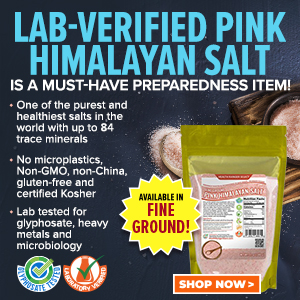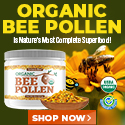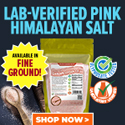
Bamboo: A Multi-Purpose Plant With Eco-Friendly Potential
Thursday, April 03, 2008 by: Cathy Sherman
Tags: bamboo, health news, Natural News
- Newly released JFK files reveal Pentagon's role in creating Lyme disease and covid in the same lab
- Oncologist warns of ‘terrifyingly aggressive’ cancers in children, linked to immune suppression from COVID vaccines
- Trump administration CUTS FUNDING to Gavi, the Vaccine Alliance - a major blow to the Bill Gates-backed entity
- Health Ranger Report: Ashton Forbes discusses TELEPORTATION ORBS and their role in MH370 disappearance
- Musk targets “strangely wealthy” lawmakers in DOGE probe, names Pelosi, McConnell, Schumer
- NIH study, buried for decades, reveals that Flu Shots INCREASE elderly deaths, not prevent them
- EPA banned chemical linked to cancer, Parkinson's and fatal heart defects in babies - now industry is lobbying to get it reinstated
- Millionaire fitness coach charged in Tesla vandalism incident as anti-Musk attacks escalate
- At least 75 percent of Americans are unknowingly MEDICATED FOR STUPIDITY by fluoridated water – Utah now banning it
- “Ethically sourced” human “bodyoids” could usher in a new era of medical exploitation, raising disturbing ethical questions
- Woman contracts WORLD'S DEADLIEST VIRUS after unknowingly being given the WRONG VACCINE
- Civil war is here – Multiple events, from conservatives being “swatted,” to attacks against Telsa owners, happening across America as Dem politicians are telling supporters to ‘fight in the streets”
- COVID-19 scandal linked to CANCER SURGE: Billionaire researcher sounds alarm
- U.K. unveils controversial pandemic preparedness tool: A double-edged sword?
- Tackling the rubber waste crisis: Groundbreaking study reveals eco-friendly method to recycle tires
- DARPA: The shadowy innovator behind the world’s most advanced military technologies
- Homesteading Boom: How families are escaping cities to grow their own food
- NYT admits U.S. ran Ukraine war operations-Russia's victory exposes obsolete NATO tactics, says Mike Adams
- Newly released JFK files reveal Pentagon's role in creating Lyme disease and covid in the same lab
- Analysis: The coming economic collapse, a mass uprising and Trump's three secret weapons to halt the growing revolt
- Trump's greatest betrayal so far: Accelerating Middle East wars, silencing dissent, and serving Zionist masters
- CDC finally halts $11 billion COVID funding scam as health officials admit the ‘pandemic’ was a fraud
- The hidden dangers in your kitchen: How cooking methods impact diabetes, cancer and aging
- Kiss Your Genetic Privacy Good-Bye! 23andMe Gets Green Light to Sell Your Intimate Genetic Details to Anyone They Want
- DEADLY DECEPTION: How COVID vaccines increased mortality rates and why authorities hid the truth
- Dr. Suzanne Humphries makes bombshell appearance on Joe Rogan podcast, exposing vaccine industry deception back to POLIOMYELITIS
- Trump nominates VACCINE ZEALOT Susan Monarez to lead the CDC, sidelining RFK Jr.'s reform efforts
- Here are TEN all-natural ways to protect your garden without using harmful chemicals
- Woman contracts WORLD'S DEADLIEST VIRUS after unknowingly being given the WRONG VACCINE
- Senate Democrats deny censorship industrial complex existed, defend government's role in silencing dissent
- Black cumin seed oil emerges as a powerful ally against breast cancer and chronic inflammation
- Sugar-free deception: Artificial sweeteners hijack hunger signals, fuel obesity epidemic, study warns
- “Independent” anti-Russia outlet MEDUZA faces COLLAPSE as US funding dries up
- The Health Ranger releases “Vaccine Zombie” song and music video, using AI-animated zombies for the music video
- Discovery of vast underground city beneath Giza pyramids challenges human history
- Key nodes of Federal Government censorship
- Newly released JFK files reveal Pentagon's role in creating Lyme disease and covid in the same lab
- California's social media censorship law struck down: A victory for free speech or a threat to online safety?
- EPA advisor admits the agency is funneling billions to climate groups ahead of Trump’s return to White House
- The Health Ranger releases “Vaccine Zombie” song and music video, using AI-animated zombies for the music video
- Dr. Mike Yeadon releases 15-minute testimony - WATCH - about genocidal intent of COVID “vaccines”
- Florida takes a stand: DeSantis proposes permanent ban on mRNA vaccine mandates
- “Why we influenced the 2020 elections”: Facebook files reveal the coordinated effort to bury the Hunter Biden laptop story
- Mike Adams releases country western hit single: Goin’ Back in Time is Comin’ Home
- The pandemic as a tool for INDOCTRINATION: Understanding “The Indoctrinated Brain” by Dr. Michael Nehls
- Unpacking the Lies That We’ve Been Fed – new song and music video released by Mike Adams, the Health Ranger
- Mike Adams releases music poetry sensation: A Child of God
- House Intelligence Committee calls for the ARREST and PROSECUTION of Dr. Anthony Fauci
- Rep. Nancy Mace introduces bill to ban biological males from female facilities on federal property
- Michigan sheriff announces criminal investigation into 2020 election crimes, Dominion Voting Systems
- Peter Rost exposes Big Pharma corruption in his book “The Whistleblower: Confessions of a Healthcare Hitman”
- Migrants are taking advantage of recent hurricanes to scam residents and loot their homes
- Sugarcane extract superior to cholesterol-lowering drugs?
- Survival 101: Effective EMF blocking techniques
- Red Cross issues warning to stop blood plasma donations from vaccinated people
- Scientists confirm: GENIUS brain function can be spontaneously unleashed in humans without any apparent cause
- EPA advisor admits the agency is funneling billions to climate groups ahead of Trump’s return to White House
- HYSSOP: What research reveals about the health benefits of this ancient holy herb
- Two containers with completed ballots fall out of truck in Florida
- Fully vaccinated about to see “tsunami” of illness and death, warns virologist
- Global leaders unite to clamp down on “misinformation” with UN-backed Cascais Declaration
- BREAKING: 2025 NDAA authorizes mandatory military draft of WOMEN across America… as Pentagon pursues global NUCLEAR war with both Russia and China at the same time
- Michael Yon warns of a ZIONIST TAKEOVER in Trump’s second administration
- BOMBSHELL: DNA testing kits are a SCAM to develop ethnic-specific bioweapons
- Ozempic and Wegovy weight loss drugs are injectable LIZARD VENOM PEPTIDES that may unleash a devastating wave of organ failure… side effects align with symptoms of SNAKE BITES
- Israeli soldiers accused of even more torture and abuse in the West Bank
- These 13 countries just signed an agreement to engineer a global FAMINE by destroying food supply
- NASA admits that climate change occurs because of changes in Earth’s solar orbit, and NOT because of SUVs and fossil fuels
- RFK Jr. clears key hurdle: Sen. Susan Collins backs controversial HHS nominee, signaling a new era for health policy
- Sermon 30: How Jesus reveals Caesar’s FAKE CURRENCY and FALSE AUTHORITY
- Coriander seeds: Ancient medicine backed by modern science
- Arizona officials claim Maricopa County needs 10-13 days to tabulate results of the election
As the fastest growing woody plant on earth, bamboo has a short growth cycle. Some bamboo species can grow up to one meter daily, which makes it a rapidly renewable resource. Because it is so versatile and high-yielding, it solves the problem of replenishing many consumables within a short time.
There are over 1600 species of bamboo which have adapted to many environments. It can be harvested in three to five years, whereas most softwoods take ten to twenty years. Bamboo also tolerates extremes of precipitation, from 30-250 inches of annual rainfall, as well as droughts.
Environmentally, this grass generates 35% more oxygen than an equivalent amount of trees while it cleanses the atmosphere of carbon dioxide and purifies the soil. Its roots help prevent erosion and rain run-off. In addition it provides shade, an acoustical barrier and a wind break.
As a building material, bamboo has advantages over wood due to its flexibility, strength and light weight. These qualities also allow it to "dance" during an earthquake. After the violent 1992 Costa Rica earthquake, only the bamboo houses from the National Bamboo Project remained standing in the affected area.
Bamboo's versatility applies to other building uses also. Ply bamboo can be used for wall paneling and
flooring, while the stalks serve as raw material for housing construction and rebar for reinforced concrete beams. Bamboo's tensile strength is 18,000 pounds per square inch, making it stronger than any other wood.
What is more exciting, it is possible to plant and grow your own bamboo home! In tropical climates, with a 20 meter by 20 meter plot, two 64 square meter homes can be constructed from the harvest in the course of five years. Every year after that, one additional house can be built per plot.
Medically, bamboo has for centuries been used in Ayurveda and Chinese medicine, including acupuncture. Its powdered, hardened secretion is used internally to treat asthma and coughs. Ingredients from the root of the black bamboo help treat kidney disease, and bamboo roots and leaves have been used to treat venereal disease and cancer. It is said that its sap can reduce fever and its ash will cure prickly heat. Current research is revealing bamboo's potential for many more health-enhancing uses.
Bamboo is also edible; it is used by the Japanese as a natural food preservative because the antioxidant properties of its pulverized bark prevent bacterial growth. Many an Asian dish calls for bamboo shoots - very young plants. It is often used as fodder for animals and food for fish.
For centuries the sound qualities of bamboo have been appreciated in uses from wind chimes to flutes. Its ambiance adds not only to the enjoyment of gardens but also home interiors. We prepare and serve foods with it and eat on it. Artists have utilized bamboo for the paper, the brush and the subject of artwork.
In addition to building with it, using it for health and nutrition and its many other practical applications, we now wear bamboo. It is used in textiles for everything from towels and underwear to men's sweaters. Bamboo offers many surprising advantages in clothing: it offers breathing/wicking properties, elasticity, softness, and absorbability. It also takes up dyes easier, which means less dye needs to be used. It is less coarse than linen, hemp and burlap - other plant-based fabrics.
The pesticide problem with cotton has not been a factor with bamboo, and because it grows like a weed, it should not require great amounts of fertilizer. Still, organic certification for bamboo is not yet available since most of the bamboo used in the states comes from China. The best we have is the "Oeko Tex Standard 100" certification, which promises that there are no harmful chemicals in the finished fiber (even if chemicals were used in the processing of that fiber).
It isn't known how long bamboo will retain its natural pest-free status. At present it is grown among other plants in a natural state. When grown as a mono-crop in response to increased demand, it might lose this quality, causing growers to resort to pesticides.
The downside of bamboo as a textile is that it is subjected to the same kind of processing procedures as cotton or rayon, in that strong solvents are required to make it suitable for any textile use. These solvents affect the environment, as they are waste products of the manufacturing process. They find their way into groundwater when they are laundered out of the finished product. The health of processing-plant workers is also impacted by the solvents.
Though less harmful, mechanical methods are also available, they are less frequently used because they are more expensive. They work by crushing the bamboo into pulp, without adding the harmful solvents. More recently developed processes include closed-loop systems such as the Lyocell process used in making Tencel, and processes using safer solvents such as acetic acid. These may be used more frequently, as the demand for organically-processed bamboo textiles increases.
As a result of these factors, bamboo textiles are a mixed bag ecologically. While the crop itself so far gets high marks environmentally, the processing has the same negatives as cotton. Advances can be made in this area, but manufacturers have to feel the demand for this. Consumers can make their desires known, and as long as they are willing to pay the price, bamboo clothing can become a greener alternative.
About the author
Cathy Sherman is a freelance writer with a major interest in natural health and in encouraging others to take responsibility for their health. She can be reached through www.devardoc.com.Bamboo at FETCH.news
Get independent news alerts on natural cures, food lab tests, cannabis medicine, science, robotics, drones, privacy and more.
Take Action: Support Natural News by linking to this article from your website
Permalink to this article:
Embed article link: (copy HTML code below):
Reprinting this article:
Non-commercial use OK, cite NaturalNews.com with clickable link.
Follow Natural News on Facebook, Twitter, Google Plus, and Pinterest
Science News & Studies
Medicine News and Information
Food News & Studies
Health News & Studies
Herbs News & Information
Pollution News & Studies
Cancer News & Studies
Climate News & Studies
Survival News & Information
Gear News & Information
News covering technology, stocks, hackers, and more



"Big Tech and mainstream media are constantly trying to silence the independent voices that dare to bring you the truth about toxic food ingredients, dangerous medications and the failed, fraudulent science of the profit-driven medical establishment.
Email is one of the best ways to make sure you stay informed, without the censorship of the tech giants (Google, Apple, Facebook, Twitter, YouTube, etc.). Stay informed and you'll even likely learn information that may help save your own life."
–The Health Ranger, Mike Adams












































